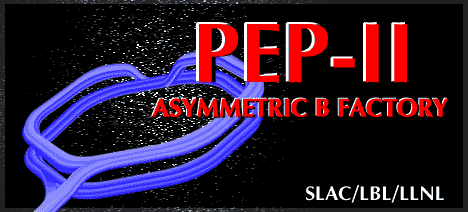 05/26/99 Update
05/26/99 Update  05/26/99 Update
05/26/99 Update
PEP-II accelerator work over the past week has concentrated on single ring
commissioning, raising the BaBar solenoid, and early collision studies.
Last week we attempted to put the two beams into collision but were unable to overlap them
vertically as seen by the interaction region position monitors. Many dipole correctors
reached their maximum strengths. Alignment issues with the near-in quadrupoles were
suspected. A repair day was used to realign the interaction region magnets.
After the alignment, we were still unable to overlap the beams but predicted that turning
on the BaBar solenoid would help. The BaBar solenoid was raised to 33% of full strength
(1535 A or 0.5T) and several shifts were spent compensating the solenoid, uncoupling the
rings, and steering the beams so they overlapped.
First reliable beam-beam signals were seen late Tuesday May 25 and full beam-beam
interactions were seen early May 26. The first BaBar data run occurred at 4 am May 26 with
a peak luminosity of about 1 to 3 x 10**31 /cm**2/s with 36 bunches and 50 mA of positrons
on 10 mA of electrons. The interaction point spot sizes (cap-sigmas) were 25 microns in
the vertical and 300 microns in the horizontal. BaBar recorded many Bhabha and
several hadronic events. The detector backgrounds were about 10% of the trip threshold for
the silicon detector and 30% of the forward calorimeter threshold. Several additional
short data runs (fills) were made over the next shift.
During collisions, the beam readings of the position monitors near the detector were
observed to have about an 800 micron vertical difference between electrons and positrons.
We later found calibration and timings problems with these position monitors causing an
unexpected e+/e- vertical offset of about 600 microns (which was quickly fixed).
The HER has stored 50 mA and the LER 100 mA with acceptable backgrounds. HER injection
gives the highest background rates at present. The injection rate is still at 1 Hz to
minimize BaBar radiation doses.
During the next week the plan is to raise the solenoid to full field (1.5T) and to
compensate the rings. A few short BaBar data runs will be interspersed.
Thank you and congratulations to all for the first collisions and detected events with
BaBar.
John Seeman 5/26/1999
Suggestions to: John Seeman
[PEP-II Commissioning Updates] [PEP-II Home Page] [BABAR Detector Home Page] [SLAC Home Page]
Page owner: achan